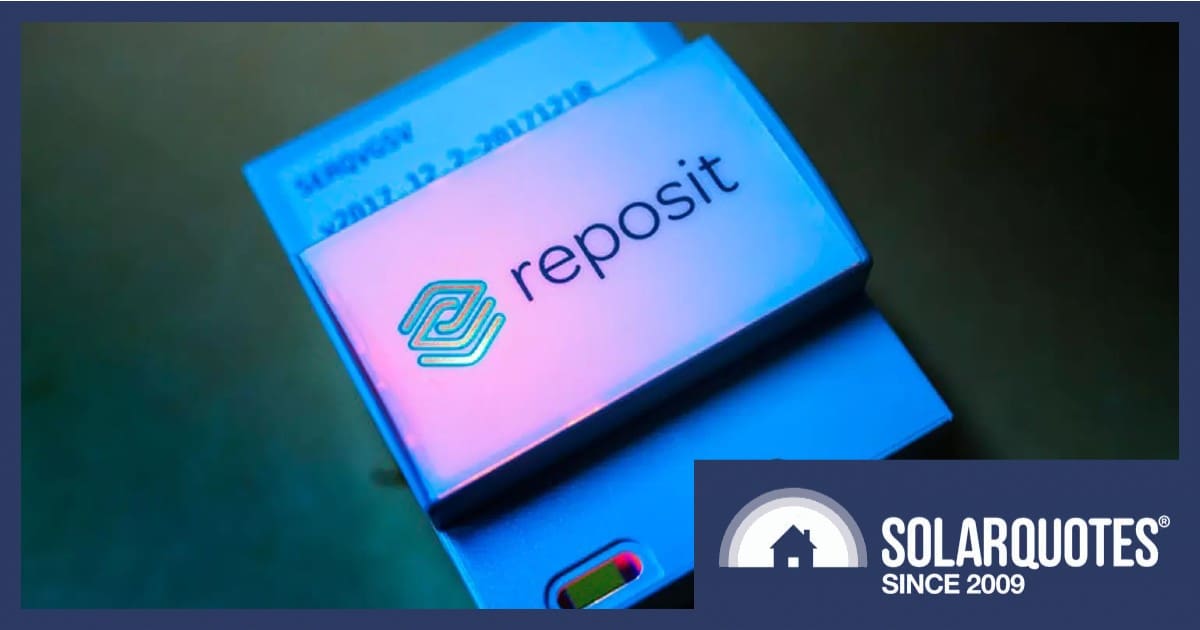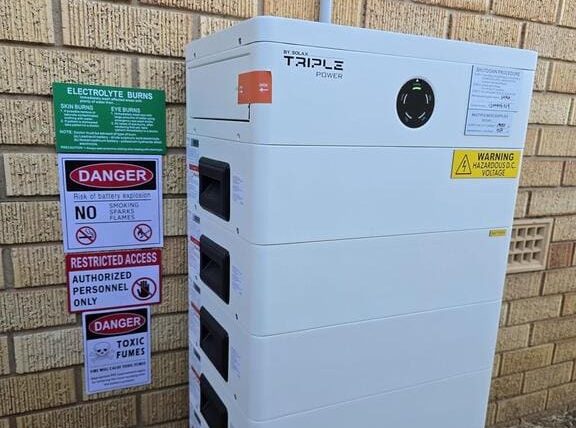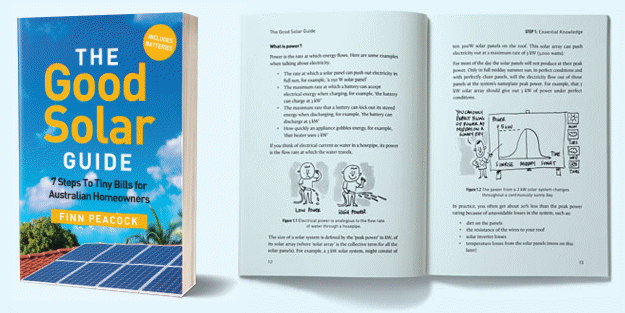
Have you got a 7 year itch for free electricity? ACT company Reposit is offering a “Reposit No Bill” deal where they’ll sell you a solar system and a home battery with a smart controller and guarantee you’ll receive no electricity bills for 7 years.
Reposit, which has been working on home battery optimisation for over 12 years, is currently offering this service in the ACT, Victoria, and Greater Sydney.
How much this deal makes sense depends on how badly you want 7 years of guaranteed no bills. But I’d say you’d have to be pretty desperate for them. With a decent-sized solar and battery system, your electricity bills are going to be very low anyway and may even be in credit. This means you could lose money by joining Reposit No Bill.
What You Get & Give
If you sign up for Reposit No Bill, you’ll receive:
- Rooftop solar
- A home battery and smart controller
- A guarantee your electricity bills will be $0 for 7 years
- A 10-year warranty on the solar and battery system
In return, you’ll have to provide Reposit with:
- Your bill history so Reposit can properly size your solar and battery system.
- A large amount of money upfront to pay for it.
- Control over the battery and the energy produced by the solar system.
- Freedom for Reposit to make money for their benefit by using your battery to support the grid.
This is enough to get you started on Reposit No Bill, but you won’t be able to keep it for the full 7 years if your electricity consumption rises too high above a baseline amount established by your bill history. If you exceed the baseline by over 20% for any three quarterly billing periods, Reposit can kick you off the No Bill guarantee.
Keeping the guarantee intact means being confident your electricity consumption won’t significantly increase for 6+ years. Buying an EV, going off gas, or having an extra person move in are all things that could cause you to exceed the +20% figure. Some good news is Reposit says they will inquire about potential changes to your electricity consumption before signing you up, so hopefully, you won’t be caught out.
Other points to keep in mind are…
- Your battery will receive wear and tear from being used by Reposit to support the grid for 7 years.
- While you’re protected for the 7-year period if electricity prices or solar feed-in tariffs fall, the flip side is you’ll receive no benefit if electricity prices fall or feed-in tariffs rise.
- While it’s marketed as providing security, there is a risk of Reposit going bust and disappearing before the 7-year No Bill period or the 10-year warranty period is over. Hopefully, this risk is only small.
Reposit No Bill’s System Size & Price
Reposit will look at your past electricity consumption and determine what size solar and battery system you’ll require. They say they will “right size” it. Because you’re paying for it you can ask for a larger system, but – for obvious reasons – they won’t want to install anything smaller than what they recommend.
If you go to the Reposit site, click on “Get an Instant Quote,” and answer some questions, then – after a delay – it will not give you a quote. What it will do is give an estimate of the system size and how much it will cost.
I tried it for Sydney, and when it asked how much I spent on electricity I clicked on “$2,000-$3,000/year”. As the average annual Sydney household bill is around $2,000, this represents an above-average consumption of around 4,800 to 8,000 kilowatt-hours per year. This is about what a 3 or 4-person household would use or a 2-person household with an electric car. It then gave me this estimate:
- 6.6 kW solar system
- 14.4 kWh battery
- Total cost: $18,990 – $22,000
That isn’t cheap. While I don’t recommend chasing the cheapest systems – you’re much better off paying for quality than getting a solar and battery system that may be poorly installed – you can get a reliable system that size from an installer who does quality work for less. One reason why is there’s a NSW Battery Rebate that lowers the cost of a 14.4kWh battery by around $2,000. If that battery becomes part of a Virtual Power Plant (VPP) there’s also an additional payment of around $300. You can estimate the rebate with our NSW Battery Rebate Calculator.1
The Solar System Is Small
The solar system size in my Reposit No Bill estimate was only 6.6kW. This is smaller than what I usually recommend. Provided there’s room on the roof, most households should be installing 10kW or more. Especially if they have above-average electricity consumption. A larger solar system directly saves money by producing more energy and also improves the return from a home battery by helping to keep it charged during winter and periods of bad weather. Because getting a larger solar system is relatively inexpensive, it’s normally a good idea. But because Reposit can charge your battery from the grid if they need to, your home doesn’t need a large solar system for them to benefit from using your battery to provide services to the grid.
Unknown Hardware
Reposit doesn’t actually state on their estimate what solar panels, inverter, or battery you’ll get. But pictures on their site show SolaX inverters and SolaX Triple Power batteries, so that’s a good bet. While the SolaX batteries pictured don’t come with a 14.4kWh capacity, the one below does.

A SolaX battery. This one has 3.6kWh modules and 4 of them will give 14.4kWh.
Backup Capacity
No mention is made on the Reposit site about backup capability, so this is something you should definitely check if you’re interested. Trust me, you don’t want to pay a significant sum for a home battery but end up sitting in the dark during blackouts. If they say the battery provides backup, ask how much reserve power Reposit leaves in battery. If they don’t provide a reserve then it will be possible for Reposit to sell all the energy in the battery to the grid, leaving you with no backup power if the grid goes down.
What If I Already Have Solar?
If you already have solar and go for the No Bill deal, Reposit will remove your current solar and replace it with their own. This means it will probably only make sense if you were considering replacing it anyway. While it often makes financial sense to replace an old small system with a large new one, Reposit systems aren’t that large.
Your Electricity Bills Go To Reposit
After joining Reposit No Bill, you don’t have to change your electricity retailer or plan, but you must arrange with your retailer to have your bills sent to Reposit and they will pay them. No mention is made in their terms and conditions of what happens if your electricity bill is in credit thanks to receiving a solar feed-in tariff. But this is unlikely to happen, given the solar systems Reposit installs aren’t very large, the battery will reduce the feed-in tariff received by storing energy for the evening, and Reposit may use some energy to support the grid.
You can join any retailer or electricity plan you like but you can’t join a VPP or a plan that lets you buy and sell electricity at wholesale prices. This is because Reposit has control over your battery and you will be part of a Reposit VPP. But note this VPP doesn’t provide you with any benefit apart from the No Bill deal.
The ‘Fair-Use Cap’
Reposit says you can increase your electricity consumption by 20% and continue to receive the No Bill guarantee.

Reposit says “Use 20% More Power” but they actually mean “Use 20% More Electrical Energy”. Once again, a company that should know better has confused power and energy.
Reposit will look at your electricity consumption over the previous 12 months to determine a baseline consumption for each billing quarter of the year. You can increase your electricity consumption by up to 20% above this baseline and still pay nothing for electricity. This is called their “fair-use cap”. But if you exceed 20% for 3 or more quarters out of the 28 quarters in the 7 year period, Reposit can terminate your No Bill arrangement.
Three quarters is 9 months, so there’s a reasonable amount of leeway. But if you’re determined to stay on the No Bill plan I’d say you shouldn’t increase your electricity consumption by more than 15% to be safe. Buying an EV, switching from gas to electric hot water, or having an extra person move in could all put you over the fair-use cap.
Reposit says you’re responsible for not exceeding the cap, but they’ll let you know when your consumption reaches 80% of the cap limit.
Reposit Controls Your Battery
As part of the deal, reposit is allowed to use your battery to provide services to the grid. This could be providing ancillary services that help keep the grid stable or buying and selling electricity at wholesale prices. While you will receive no benefit from this — apart from no electricity bills — you can suffer the drawbacks of:
- Extra wear and tear on your battery that can reduce its lifespan and capacity.
- Little or no stored electricity may be available when a blackout occurs because Reposit sold it.
Assuming the Reposit battery is of decent quality, the deterioration from extra wear and tear shouldn’t amount to much. But it’s still something to keep in mind. Because Reposit provides a 10-year warranty, they have an incentive not to trash your battery before it ends. But they also don’t have a financial incentive to preserve the battery so it lasts beyond the end of its warranty.
Internet Requirements
Your internet connection may be used if Reposit can’t get a reliable 4G signal. In this case, Reposit will use around 500MB of your internet data per month. For comparison, the novel Moby Dick takes up 1MB. So, on average, Reposit will Moby Dick your internet every hour and a half for seven years.
Backing Out
You can get out of the No Bill arrangement by giving Reposit 30 days notice in writing. The solar system and battery remain yours. There are no fees or penalties involved with backing out. You’ll just have to pay electricity bills — or perhaps receive electricity bill credits — as normal.
What Happens After 7 Years?
At the end of the 7 years No Bill period, one option is to simply start paying electricity bills normally. Because you have solar and a battery, these are likely to be low. You may even start receiving an electricity bill credit. If you do, feel free to kick yourself for using Reposit No Bill. Your solar system and battery will remain under warranty for 3 more years.
If you decide you want another 7 year No Bill period, then things get a bit weird. Reposit says you can have another 7 years, but you have to buy a new battery from them. Because they give a 10 year warranty, this means they’ll be replacing a battery that should still have years of life left in it. I can understand them thinking a 7 year old battery may not be reliable enough to last another 7 years, but this seems wasteful. On the bright side, batteries could cost a lot less in 7 years time, so replacing them may not be financially painful.
My Conclusion — Only For Those Desperate For No Bills
If a typical Sydney household installed a 6.6kW solar system and a battery with around 14kWh capacity, then — provided they have an appropriate plan — their electricity bills are likely to be in credit by a couple hundred dollars per year. They’re still likely to be in credit even if their electricity consumption is 50% above average. To become more confident of receiving an electricity bill credit, the household could simply install a larger solar system.
If the household wants to improve the return further, they also have the option of joining a VPP. In NSW there is a rebate of around $300 for doing so and VPP payments can also be received. These are usually low and may only come to around $100 a year, but it still helps. See our comparison table for VPPs for more detail on what options are available.
Thanks in part to NSW rebates, a solar and battery system of the same size as in the Reposit estimate I received can be installed in Sydney by a professional who does quality work for the same price or less than Reposit’s figure.
For these reasons, I don’t recommend using Reposit No Bill unless you are desperate to lock in no bills for 7 years. While you’ll be protected from electricity price increases, you’ll also miss out on the potential to come out financially ahead. If you’re interested, you can check what Reposit offers for your situation. But I strongly recommend checking your other options for solar panel systems and battery storage, and making sure you won’t be making yourself worse off by signing on the dotted line.
Footnotes
- When calculating the rebate I used a PRC amount of $1.70 rather than the default $2 figure. This gave a battery rebate of around $135 per kWh with an extra $20 per kWh for joining a VPP. ↩

 RSS - Posts
RSS - Posts



I like to commend this blog to anyone interested in the development solar and battery solutions..
The blog is interesting and very informative. Keep up the good works, guys.
Hans Rijsdijk
Albion Park Rail, NSW
“you’ll receive no benefit if electricity prices fall or feed-in tariffs rise.”
Lol, yeah I think there’s more chance of a snowstorm in hell than that happening, significantly at least.
We had a period through a year or so when rates went up 40% (SA), and when we had a recent drop in rate due to wholesale price decreases, we got about 1 point something cents off in our new rates for peak, shoulder, off peak . . . peak of just over 50c !!
It was a decrease in rates of about 1% or so.
Knowing what I know now 13 – 14 months after our 11.23kw system went in, if (when) we get either a home battery, or a V2G/H BEV, we will be using it to just be self sufficient for at least 3/4 of the year, winter we might need to charge the battery briefly in the 0000-0600 EV time to top it off for 8c/kwh.
As the ever shifting goal posts change with govco / energy authority policies, we will have to adapt as retailers continue to milk consumers for all they can.
In Canberra and Victoria at least, its not clear to me how you could be in credit without Reposit, as you can use more power in winter than the system produces which you would otherwise have to pay for and you generally export like crazy in summer when you would be paid a whole 8 cents/kwh or whatever. Then there is the $400 fixed supply cost.
Plus you dont face time of day pricing with Reposit, which is a pain for consumers and even the AEMC is beginning to realise that complex pricing plans are a nightmare. Its not clear that things like Amber actually work for consumers as you are exposed to wholesale prices suddenly rising, and it is also hugely complex again.
You just have to manage your allowance or “cap”, which admittedly can be complex if you change your electricity consumption pattern or add extra things like an EV or electric hot water.
This is by far the biggest issue with Reposit, as if you dont use most of your allowance you are wasting it, but you cant go over the cap too often. Especially if they put you on a monthly baseline, as they seem to want to do, as you could breach this in three months. I suggest insisting on being on a quarterly baseline, so you can respond to sudden hot or cold spells without going over a monthly cap.
Adding extra things like EVs is almost impossible, as it is very difficult to expand their systems, and you cant buy extra cap or borrow from or lend to other customers.
It is hard to judge how much you pay for No Bill upfront in extra cost, as el cheapo systems bring their own problems as you say. Its really worth putting in a larger system from the beginning, such as 10kw panels and 10kwh inverter if you have three phase, as the extra cost is not huge and it means you have some spare cap up your sleeve.
Overall, Reposit is a good product if you want the simplicity of No Bill and not facing time of day pricing, as long as you arnt going to increase your electricity consumption and you get a quarterly baseline.
Hi Neil, from what I have seen, Vic and ACT should be far ahead of SA for recouping solar / battery, and being self sufficient.
(I wouldn’t personally use Reposit if I was in a state / position to need it.)
Vic and ACT especially have much lower peak TOU rates than SA (ACT was before a recent modest rise about half SA rate).
Making a solar / battery set up work for you is all totally determined by your usage patterns and ability to self consume a lot during solar production, and then have a battery to store / use your excess, first to a battery (and / or HWS, EV, etc).
With our system as mentioned in the post above this, in Summer we export 75% to 85% or production to the grid (1mwh to 1.5mwh exported a month), using about 400kwh.
In Winter we are exporting around 60%, 230kwh, consuming on the whole about 440kwh / month in winter, self consuming 40% of that during the day.
So our net exported is about 265kwh, enough I feel to enable us to get by.
I feel confident we could manage with 10kwh -13kwh of storage easily, but if we needed to in Winter we could top off a battery (or a small 2nd hand EV) at 8c during the early hours 0000-0600.
Of course some households use a lot more power, and some a lot less . . . we are a couple, semi retired, can self consume a heap of power.
One thing with Reposit, from the wording about warranties etc, I wonder what would happen with a major inverter / panel / battery malfunction, or very premature system output reduction, it’s in Reposit’s interest to see it fixed fast, they are obviously reselling the power in the wholesale market to make their bonus $.
But if it’s in the owners / system manufacturer / solar companies hands, it could drag out.
I also wonder what the initial outlay is with Reposit, and how it compares with regular solar / battery companies.
HI Les
Yes agree entirely it is all about usage patterns and Reposit would not really be worth it if you can self consume and export all year round.
However Canberra is cold in winter and we use > 1000 kwh a month over six months, having replaced gas heating, so we import a lot in these months. We only have a 5 degree roof and personally I would have put bracket stands in, but this was an extra charge, so winter production is down.
With our consumption pattern and output, Actewagl’s retail offer would cost a lot, and their VPP is actually more expensive to buy electricity. Their VPP will also pay you $100 a year which is hardly worth getting out of bed for, especially as they will drain your battery more meaning you have to buy more electricity.
Reposit’s customer service is pretty good and it is a real advantage that they have an incentive to keep your system working and also have more clout with Solax than a single customer would.
Canberra is expensive for everything and Reposit were not really more expensive than others, but in Mebourne they seem to be a lot more although you save the hassle of dealing with sharky providers.
So personally I think Reposit works well if you are a big winter electricity user, can afford to put in a bigger system from the start and prefer not to have the hassle of dealing with solar companies and electricity retailing complexities.
Cheers Neil.
I guess they put in a decent sized system, and battery at least Tesla Wall capacity.
Very glad I did the research beforehand, solarquotes and other on youtube, and got the biggest system that would work on our roof areas.
My mate got 6kw system same time and although his bills were far lower than ours, in winter he struggled to make that some days, funny though in summer it kicks out 30-35kwh a day.
All the best with our setup, at least it will help immensely, although I shudder at what power might cost in 5 years, 10 years, and what rules are changed to keep power cos profits and share prices on the continual rise.
Hi Les
Yes, we do have a 17.4 kwh battery. While there are some concerns about SolaX quality, it seems to have improved a lot and you do have the effective double warranty with Reposit being keen to make sure the system works
Actually Reposit may still work for people who have a system that does not need to import power in winter. Many of the disadvantages of Reposit, that you can’t increase consumption above your cap and they want you to buy new batteries after seven years, aren’t a problem as you can simply leave with no penalty.
Reposit presumably charge less if your consumption pattern in places like Sydney is not weighted towards winter. Then it becomes more a simple upfront cost comparison, plus you have the benefit of the simplicity and increased warranty benefits, and you can simply leave if you want to.
Repository will pocket all electricity subsidies from the government.
Yes, they have kept the $300 rebate, but pass through the STCs and battery subsidy at the onset.
Thanks for this. Bullet dodged.